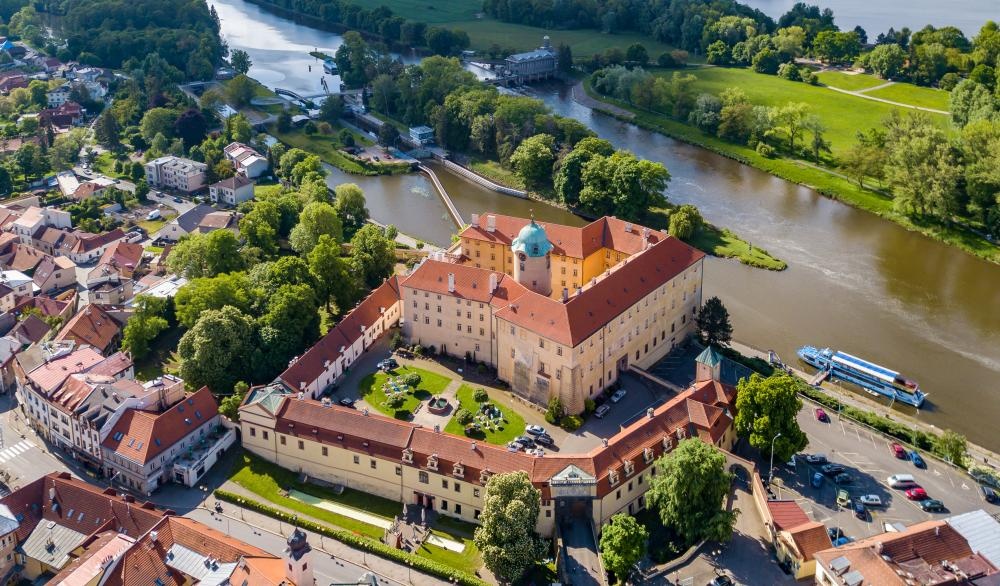Podebrady

■ Basic Information:
Geographic Location
Podebrady is a historic spa town located in the Central Bohemian Region of the Czech Republic, situated on the banks of the Elbe River (Labe). It lies approximately 60 kilometers east of Prague.
South of the town is located Poděbrady Lake. It is a 260 ha (640-acre) large lake, created by the flooding of an excavated sandstone quarry. It is mainly used for recreational purposes.
Population
As of 2024, the town has a population of around 15,000 residents.
Climate
Podébrady experiences a temperate continental climate with warm summers and cold winters, making it ideal for year-round visits.
■ History:
Etymology
An ancient community and a small fortress originated near the ford. It is most likely that the position of this community is reflected in the present name of the town: pode brody = "below the ford".
In history
The first written mention of Poděbrady is from 1223, the first unverified mention is from 1199.[4] A long-distance trade route running from Prague to eastern Bohemia and then on to Silesia and Poland passed through the then-forested landscape interwoven with a dense network of river branches. This important communication intersected the Elbe River to the west of the present town, at a place called Na Vinici. The Poděbrady estate was private, but between 1262 and 1268, it became the property of King Ottokar II as escheat, and he built a stone water castle in Poděbrady. The place has become a popular destination for rulers due to its proximityto Prague and the possibility of hunting in local forests.
A historic milestone of the history of the town was the year 1905, when it was visited by the German estate owner Prince von Bülow. This well-known water diviner marked the place of a strong spring in the castle's inner courtyard, which was later bored to a depth of 97.6 metres (320 ft). The discovery of carbonic mineral water resulted in the opening of the first spa in 1908. After World War I Poděbrady rapidly changed into a spa town which from 1926 specialized in the treatment of cardiovascular diseases, rapidly gaining renown not only in the Czech Republic, but also abroad.
■ Administrative Details:
Presently
Poděbrady is made up of the town parts of Poděbrady I–V and the villages of Kluk, Polabec, Přední Lhota and Velké Zboží.
■ Cultural Highlights:
City center
The historic centre is made up of Jiřího náměstí and its surroundings. The main landmark is Poděbrady Castle. It was rebuilt to its current form in 1752–1757 at the behest of Maria Theresa. Today it serves as a museum and monument of George of Poděbrady.
The square is made up of terraced houses of Renaissance and Baroque origin and former Renaissance town hall from the 16th century, nowadays a library. The Neo-Renaissance building of the Civic Bank from 1898 is also valuable. The Baroque Marian column dates from 1765. A significant element of the square is the Monument of King George with his equestrian statue, created in the Neo-Renaissance style in 1890–1896 according to the design by Bohuslav Schnirch. Since 2024, it has been protected as a national cultural monument.
Spa
The large spa park with a modern colonnade is also a part of the urban monument zone. The oldest part of the park was created on the site of a former manor park according to the project of architect František Janda. Gradually, more parts were added and the park expanded. The glass colonnade of Professor Libenský was built in 1938. The colonnade was built above a spring of mineral water.
Power plant
The most valuable technical monument is the Poděbrady hydroelectric power plant. It is a Neoclassical building designed by Antonín Engel in 1913, built in 1914–1919. It is valued for still functional technology and its architectural solution. It is one of the oldest locks in the Middle Elbe and at the same time a valuable example of technological and operational solutions for this type of waterworks.[15] The power plant is protected as a national cultural monument.
